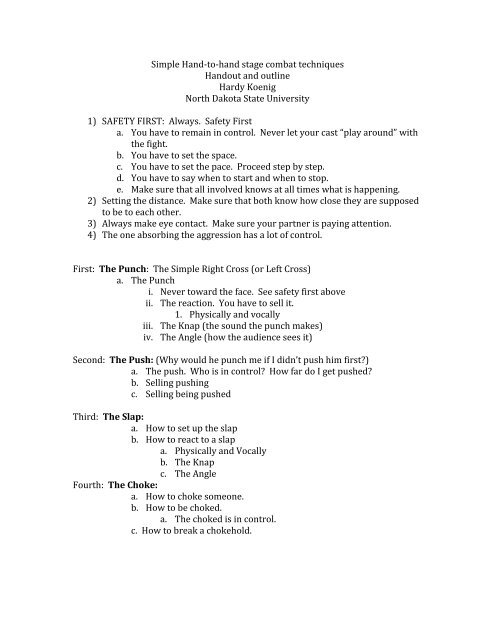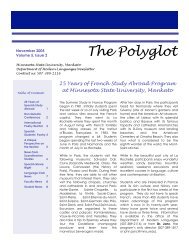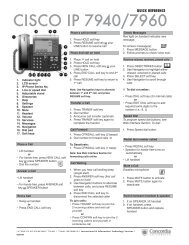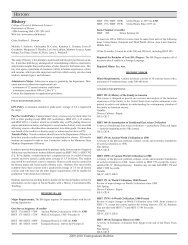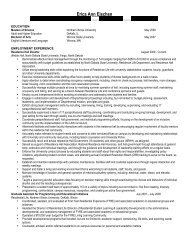Simple Hand-to-hand stage combat techniques Handout and outline ...
Simple Hand-to-hand stage combat techniques Handout and outline ...
Simple Hand-to-hand stage combat techniques Handout and outline ...
You also want an ePaper? Increase the reach of your titles
YUMPU automatically turns print PDFs into web optimized ePapers that Google loves.
<strong>Simple</strong> <strong>H<strong>and</strong></strong>-<strong>to</strong>-<strong>h<strong>and</strong></strong> <strong>stage</strong> <strong>combat</strong> <strong>techniques</strong><br />
<strong>H<strong>and</strong></strong>out <strong>and</strong> <strong>outline</strong><br />
Hardy Koenig<br />
North Dakota State University<br />
1) SAFETY FIRST: Always. Safety First<br />
a. You have <strong>to</strong> remain in control. Never let your cast “play around” with<br />
the fight.<br />
b. You have <strong>to</strong> set the space.<br />
c. You have <strong>to</strong> set the pace. Proceed step by step.<br />
d. You have <strong>to</strong> say when <strong>to</strong> start <strong>and</strong> when <strong>to</strong> s<strong>to</strong>p.<br />
e. Make sure that all involved knows at all times what is happening.<br />
2) Setting the distance. Make sure that both know how close they are supposed<br />
<strong>to</strong> be <strong>to</strong> each other.<br />
3) Always make eye contact. Make sure your partner is paying attention.<br />
4) The one absorbing the aggression has a lot of control.<br />
First: The Punch: The <strong>Simple</strong> Right Cross (or Left Cross)<br />
a. The Punch<br />
i. Never <strong>to</strong>ward the face. See safety first above<br />
ii. The reaction. You have <strong>to</strong> sell it.<br />
1. Physically <strong>and</strong> vocally<br />
iii. The Knap (the sound the punch makes)<br />
iv. The Angle (how the audience sees it)<br />
Second: The Push: (Why would he punch me if I didn’t push him first?)<br />
a. The push. Who is in control? How far do I get pushed?<br />
b. Selling pushing<br />
c. Selling being pushed<br />
Third: The Slap:<br />
a. How <strong>to</strong> set up the slap<br />
b. How <strong>to</strong> react <strong>to</strong> a slap<br />
a. Physically <strong>and</strong> Vocally<br />
b. The Knap<br />
c. The Angle<br />
Fourth: The Choke:<br />
a. How <strong>to</strong> choke someone.<br />
b. How <strong>to</strong> be choked.<br />
a. The choked is in control.<br />
c. How <strong>to</strong> break a chokehold.
Some Terms you may like <strong>to</strong> know.<br />
Eye Contact – Technique of frequent cueing your partner by looking in<strong>to</strong> their eyes<br />
during a fight, in order <strong>to</strong> assure connection between partners.<br />
Performance Speed – Stage <strong>combat</strong> should always be first rehearsed in slow-motion <strong>and</strong><br />
slowly get faster. There are four performance speeds: ¼ speed (slow-motion), ½ speed (a<br />
little faster than slow-motion), ¾ speed (almost full speed) <strong>and</strong> full speed.<br />
Knap – Sound created by ac<strong>to</strong>rs <strong>to</strong> make a sound with their own bodies that mimics the<br />
sound of the blow.<br />
o Body Knap – The sound made by striking a major muscle group on the body.<br />
Either partner can make this knap.<br />
o Clap Knap – The sound made when both <strong>h<strong>and</strong></strong>s clap <strong>to</strong>gether, usually made by the<br />
victim.<br />
o Slip <strong>H<strong>and</strong></strong> Knap – The attacker claps <strong>h<strong>and</strong></strong>s <strong>and</strong> follows through during the act of<br />
delivering the strike.<br />
o Shared Knap – The sound made when the attacker’s open <strong>h<strong>and</strong></strong> meets his<br />
partner’s open <strong>h<strong>and</strong></strong> or major muscle group.<br />
Slap – Hit with an open <strong>h<strong>and</strong></strong>.<br />
o To face:<br />
Shared knap – The partner being hit holds open <strong>h<strong>and</strong></strong> under their chin<br />
with elbow close <strong>to</strong> side (audience is <strong>to</strong> their back). The partner hitting,<br />
slaps the open <strong>h<strong>and</strong></strong> <strong>to</strong> make the sound, <strong>and</strong> right after the hit, the partner<br />
holds <strong>h<strong>and</strong></strong> that was just hit <strong>to</strong> their cheek that was “hit”.<br />
Clap knap – The partner being hit claps their <strong>h<strong>and</strong></strong>s <strong>and</strong> reacts <strong>to</strong> the slap<br />
as their partner moves their <strong>h<strong>and</strong></strong> across the front of their partner’s face<br />
(keeping a safe distance from the face).<br />
Punch – Hit with a closed <strong>h<strong>and</strong></strong> or fist.<br />
o To s<strong>to</strong>mach – Punch with whole body, but pull back the energy right after the hit,<br />
<strong>and</strong> open the <strong>h<strong>and</strong></strong> as it hits the stiff, contracted s<strong>to</strong>mach <strong>to</strong> make a good body knap<br />
sound.<br />
o To face:<br />
John Wayne – If right-<strong>h<strong>and</strong></strong>ed, have feet shoulder-length apart <strong>and</strong> left<br />
foot in-between the victim’s feet, <strong>and</strong> rest left <strong>h<strong>and</strong></strong> on the victim’s right<br />
shoulder (the fighters should be facing each other). Pull back right-<strong>h<strong>and</strong></strong><br />
<strong>and</strong> punch across face, <strong>and</strong> open the <strong>h<strong>and</strong></strong> <strong>to</strong> clap the <strong>h<strong>and</strong></strong>s <strong>to</strong>gether as<br />
they go in front of the victim’s face <strong>to</strong> make a good slip <strong>h<strong>and</strong></strong> knap sound.<br />
Clench the fist again after making the knap.


